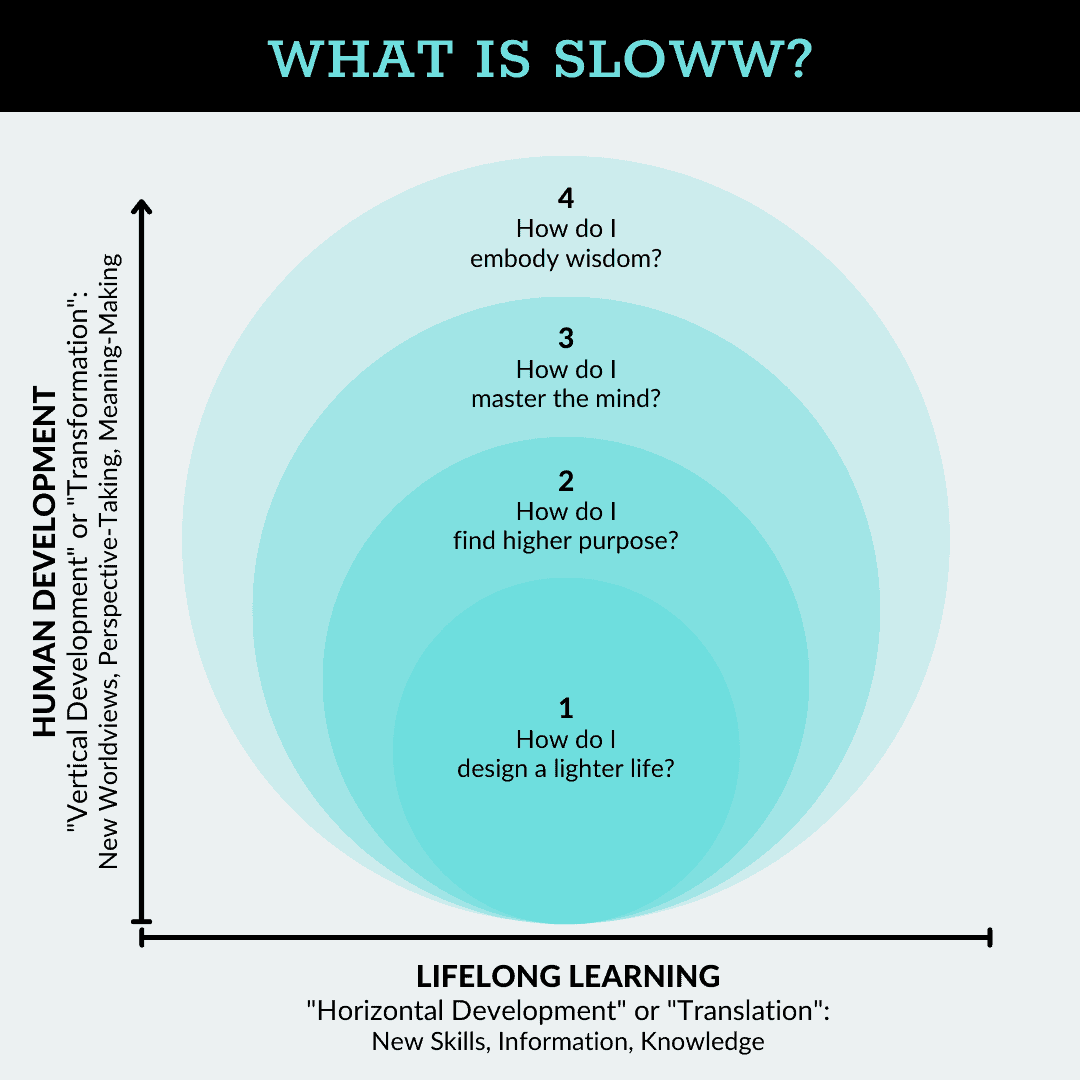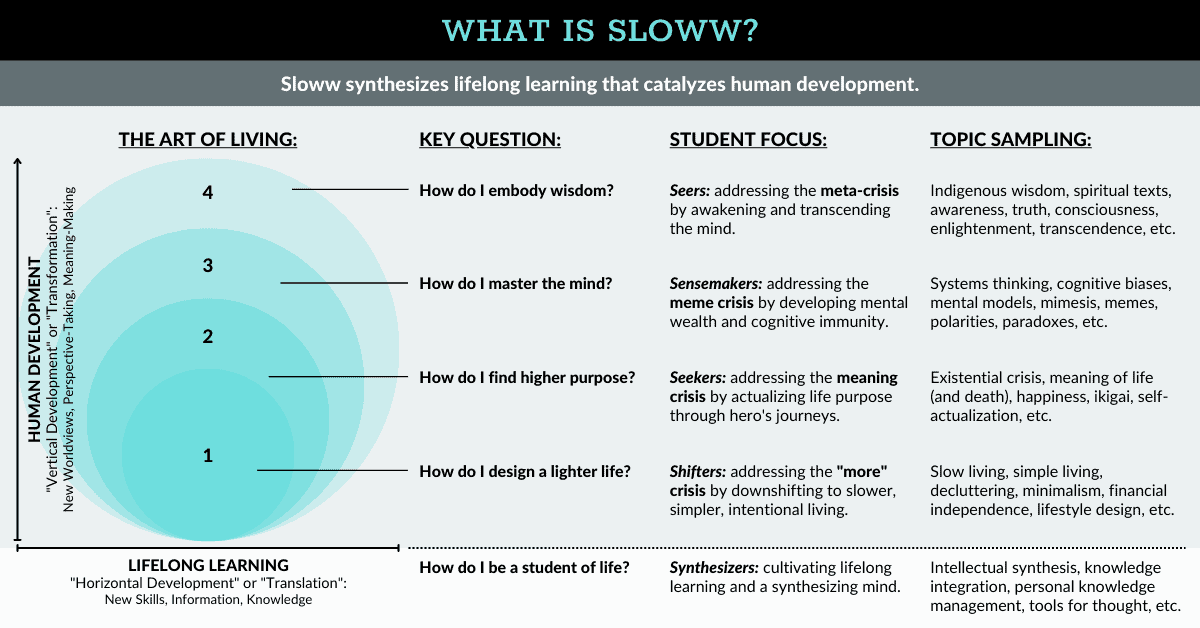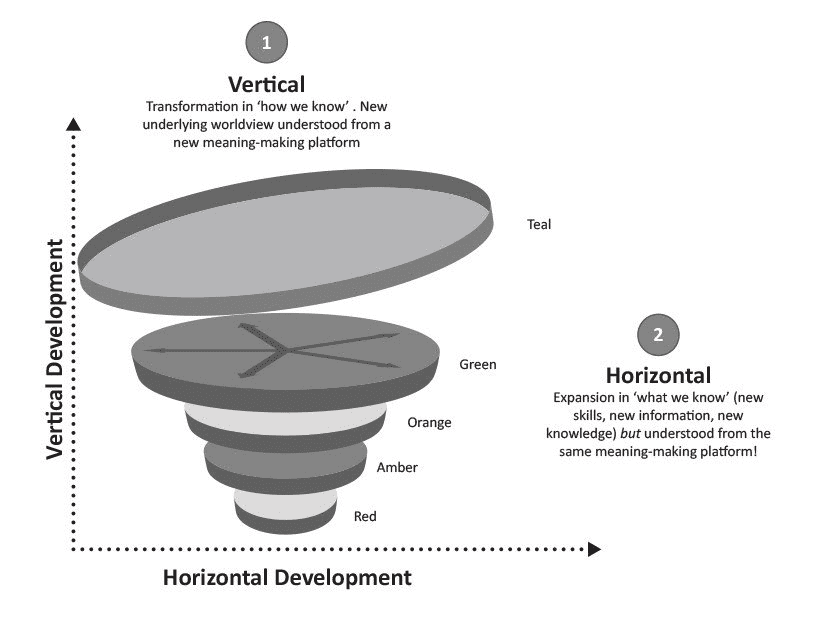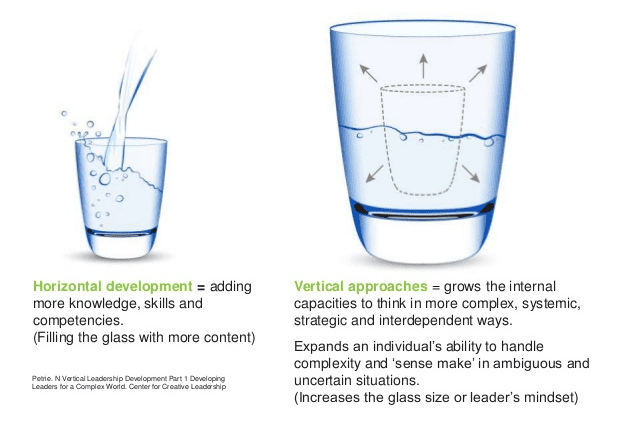What are horizontal and vertical development?
How do they differ, and how do they interconnect?
The concept of “human development” (or psychological development) has completely transformed how I view myself, others, and humanity as a whole—it’s one of the 10 most life-changing ideas that I’ve ever discovered.
Post Contents:

Human Development 101: What are Horizontal & Vertical Development?
Horizontal & Vertical Development Defined
Throughout this post, you will see references to Ego Development Theory—the human development model from Susanne Cook-Greuter (building on Jane Loevinger’s work) that has resonated the most with me to date.
Susanne says, “Ego Development Theory (EDT) is a theory of self-identity and how it forms and changes over time. It includes horizontal development as well as the potential transformation from one view of reality to a broader, more inclusive one (vertical development). It describes a sequence of how people’s mental models of reality evolve.”
Horizontal development is…
· what you think/know.
· also known as “translation” or “transfer” (lateral expansion at the same stage).
· examples include developing new skills, adding information and knowledge, transferring information/knowledge from one area to another (note that how someone views and acts on the same information/knowledge may be different at each different stage of vertical development).
· does not necessarily shift our worldview, sensemaking, meaning-making, belief system, or challenge fundamental assumptions we might be holding about ourselves, others, and the world.
· more common than vertical development (it’s more common to see horizontal translation within conventional stages than vertical transformation to postconventional stages).
Susanne Cook-Greuter (Ego Development Theory) says:
- “Most growth in adulthood seems to occur within a given stage, variously described as lateral or horizontal development or ‘translation’ in (Ken) Wilber’s terminology. The current way of viewing the self and reality is refined, enriched, and modified to include more diverse domains, more contexts and detail, and to establish more connections among them. We learn new skills, new methods, new facts, even new ways of organizing knowledge. The later the stage, the more room for such horizontal expansion exists while the current stage or mental model of the world remains the same.”
- “They may expand horizontally and add new capabilities at the same level they are already inhabiting.”
Vertical development is…
· how you think/know.
· also known as “transformation.”
· examples include growth to a new psychological stage with new meaning-making and perspective-taking that’s more holistic than the prior stage(s).
· transforms our view of reality, changes our interpretation of experience very distinctively, reaches a “higher altitude” (note that it can also be “vertical down” which is temporary or permanent regression to earlier stages due to life circumstances, environment, stress, disease, etc).
· rarer than horizontal development (rarer to see vertical transformation to postconventional stages).
Beena Sharma (VeDA, Vertical Development Academy):
- “When we talk about human development, we make this distinction between horizontal and vertical development … We see vertical development as a good outcome of healthy horizontal development so those two are a polarity—they are interdependent and interconnected.”
- “When we continue to psychologically grow, there are times in our lives we suddenly are upon a new stage of understanding something in a different way. We may have gone through a life experience, and we may have had ideas about it that didn’t fit reality. So, reality pushes us to reinterpret what’s going on, and in some ways, compels us to come up with a new way to explain what is going on—and we come into a new stage.”
Susanne Cook-Greuter (Ego Development Theory):
- “The need for meaning drives people to integrate into their existing conceptual frames of reference every difference that enters awareness by either labeling it or filtering it out. Persistent discrepancies that cannot be accommodated through horizontal integration or defensive mechanisms may induce a restructuring of the previous framework (mindset) into a more coherent new whole.”
- “They may transform vertically to new ways of seeing reality.”
- “The transition to the first postconventional stage is a watershed in so far as it is the first time that the vertical move and the questioning of previously unexamined ideas is no longer supported by society and its chief conventional representatives.”
- “Although rarer, upward vertical development can occur throughout life. In that case, the whole previous meaning system is transformed and restructured into a new, more expansive and inclusive self-theory and theory of the world.”
Watch out for “aboutism”:
Psychological knowledge (horizontal development) ≠ psychological growth (vertical development).
When learning about psychological theories (e.g. Ego Development Theory, Integral Theory, etc) it’s possible to confuse the knowledge you’re adding to your mind about the theory with actual psychological development.
Susanne Cook-Greuter (Ego Development Theory):
- “There is the problem that knowing about something has little relationship to being able to integrate that understanding into one’s living and being. A trend we call ‘aboutism.’ One can learn to reason more complexly about a moral dilemma, for instance, or pass a test on Wilber’s AQAL theory. Yet such knowledge can remain espoused theory rather than theory-in-action as defined by Chris Argyris and David Schoen (1977). According to these authors, people are guided in their actions by mental models about the world, that is by tacit, unexamined maps or a set of unconsciously held beliefs, assumptions and rules. These are rarely congruent with the explanations that people give to themselves and others to make sense of why they do what they do.”
- “‘Aboutism’ has become an issue in many specialized disciplines. On the surface, they deal with postconventional topics from strategic planning to systems theory. However, such knowledge can be acquired as objects of knowledge from a conventional mindset. One can know all about the topic without ever integrating it into one’s own personal meaning-making. This is why we call it ‘aboutism.’ This confusion between knowing about something versus embodying it has become an issue in the integral community where one can learn everything about the elegant and complex AQAL theory and then get tested on one’s knowledge. A high score on the test does not guarantee that one has integrated this knowledge into one’s being. Nonetheless, thinking about and learning new distinctions is one of the levers, we believe, in ongoing development. Its power must not be underestimated. ‘Fake it till you make’ it is a common adage in the developmental context. Being exposed to people and meaning-making beyond one’s own does seem to stimulate and support growth.”
- “Achievers (EDT stage) can create complex theories as well as learn all about complex topics. However this is done from an external point of view: They can learn to know everything there is to know about a theory without transfer of the conceptions to their interior life. Thus, one can pass a test in integral theory, for instance, and yet hold the theory as an Achiever. In EDT, we call this external knowing about complex theories ‘aboutism.’ High intelligence and access to cognitive complex thought can seduce individuals to overestimate their ego-development. Accordingly, cognitively-oriented developmental theories and measurements also tend to privilege sheer intellectual prowess, memory, and the complexity of arguments over a more holistic, integrated view of personality. EDT offers a view of development that includes an assessment of how individuals hold the knowledge they have and how they relate to their knowing. It offers a path that not only values intelligence, but a way of looking at human growth that values self-awareness, compassion and wisdom.”
3 Metaphors for Horizontal & Vertical Development
The cup, the ladder, and the library ladder.
The Cup:
· Horizontal Development = filling one’s cup of knowledge.
· Vertical Development = expanding the size of one’s cup.
Susanne Cook-Greuter (Ego Development Theory):
- “The horizontal development frequently exhibited in personal development plans speaks to filling an individual’s ‘cup’ of knowledge, whereas vertical leadership development aims to expand that person’s ‘cup’ overall, so that they can better utilize their own skills and abilities (Petrie, 2014). Vertical leadership development is often a lifelong process, involving extensive learning and growth over a long period of time. However, vertical leadership development can be cultivated if the right circumstances are provided, which typically requires heat experiences (complex situations that challenge a leader’s current ways of thinking), colliding perspectives (when leaders are encountered with new perspectives, insight, and scenarios), and elevated sensemaking (an ongoing reflection or facilitated growth process that allows the leader to process and contextualize their growth) (Petrie, 2015).”
The Ladder:

· Ladder = vertical development (each rung is a stage).
· Climber = the ego that is navigating reality, making meaning, and stepping into more expanded perspectives.
· View = each stage is a distinctly different worldview (earlier stages cannot understand the view that they don’t yet have access to whereas later stages are able to understand earlier stages).
Ken Wilber (Integral Theory):
- Ladder (basic rungs of awareness; once they emerge they remain in existence as basic building blocks or holons of consciousness): “The ladder metaphor is useful because it indicates that the basic components of consciousness do emerge in fairly discrete stages, and if you destroy a lower rung, all the higher rungs go with it.”
- Climber (self; climber of the basic rungs): “The ladder is basically selfless—there is no inherent self-sense in any of its rungs. But the self appropriates these rungs, or identifies with them, and this generates various types of self-identity and various stages of self-growth, until the self falls off the ladder altogether in radical Emptiness … Not only are these basic levels growing and unfolding, but the self has to actually negotiate them, has to actually climb the developmental rungs of expanding awareness, and the self can take a bad step at any rung—and get very badly hurt.”
- Fulcrums (each step in the climb is a fulcrum; a 1-2-3 process): 1 (identify / fusion / embed): The self evolves or develops or steps up to the new level of awareness, and it identifies with that level, it is ‘one with’ that level. 2 (dis-identify / differentiation / transcend): It then begins to move beyond that level, or differentiate from it, or dis-identify with it, or transcend it. 3 (integrate / integration / include): It identifies with the new and higher level and centers itself there. The new rung is actually resting on the previous rungs, so they must be included and integrated in the overall expansion, and that integration or inclusion is the third and final subphase of the particular fulcrum.
- View (changing view of self and other at each stage including a different self-identity, self-need, moral sense): “At each rung in the developmental unfolding there is a different view of the world—a different view of self and of others—a different worldview. The world looks different—is different!—at each rung in the developmental unfolding. As we have constantly seen, different worldspaces, different worlds, come into being as consciousness evolves—there is not simply a pregiven world that is monologically reflected! … At each rung you get a different type of self-identity, a different type of self-need, and a different type of moral stance. All of these are aspects of the different worlds that unfold at each rung or level or sphere of awareness … The self will now reinterpret every single event of its previous life history from the perspective of the new worldview. It completely rewrites its history from within the new and higher paradigm.”
The Library Ladder:

I’d like to propose a more memorable metaphor that builds on the ones above—I call it the “library ladder.” The library ladder takes everything in this post into account. The reason I find this more compelling is because it keeps the danger of “aboutism” top of mind (e.g. just because you read a book about something on shelf 5 doesn’t mean you are standing on the ladder rung for shelf 5).
· Horizontal Development = adding/expanding what you think/know by reading books, learning concepts, etc on one shelf (each shelf represents a stage).
· Vertical Development = transforming how you think/know by moving up the rungs of the ladder to a new shelf (where one is now able to see and understand everything that came before in a new, more holistic context).
What is Sloww’s role in human development?
In a nutshell, Sloww synthesizes lifelong learning (horizontal development) that catalyzes human development (vertical development). For more, see What is Sloww?
Do you remember what Beena and Susanne said above?
- “We see vertical development as a good outcome of healthy horizontal development so those two are a polarity—they are interdependent and interconnected.” — Beena Sharma
- “Thinking about and learning new distinctions (horizontal development) is one of the levers in ongoing (vertical) development. Its power must not be underestimated … Being exposed to people and meaning-making beyond one’s own does seem to stimulate and support growth.” — Susanne Cook-Greuter
It took me years to realize that this is essentially what I do personally, as well as what I offer to the world publicly. It’s been my own lived experience that my own lifelong learning has catalyzed my own human development. I fully believe that by synthesizing what I’ve learned, I can help catalyze the human development of others as well.
The visuals below show how a lifelong learning structure (horizontal development) supports all human development stages (vertical development). So far, my lifelong learning has been the catalyst for at least 4 stages of human development:
- Sloww Stage 1: How do I design a lighter life?
- Sloww Stage 2: How do I find higher purpose?
- Sloww Stage 3: How do I master the mind?
- Sloww Stage 4: How do I embody wisdom?


That’s it (for now)! What do you think? Please let me know in the comments.
You May Also Enjoy:






